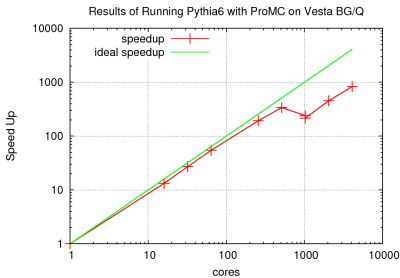User Tools
Sidebar
This is an old revision of the document!
Table of Contents
Benchmark tests
IO benchmarks using ProMC format
(E.May)
A number of IO tests are being performed on BlueGene/Q using Pythia8 and Pythia6 MC with the output to ProMC data format
A test to see if I can edit this page! - edmay A link to old Ed May webpages of Vesta work.
Some comments on data/plots of running Pythia6 with ProMC & ProBuf on BG/Q Vesta. This uses the Fortran code from the latest 1.1 tar file which simulates 5000 event per core for pp at 4on4 TeV. Except for the normalizing point at 1 core, all runs use 16 cores per node. Jobs were run through 4096 cores. This last point produced 20.5 M ev in 1197 sec (20 mins).
Fig 1
The first plot shows the (inverse) rate as a function of core. There is a noticiable jog at 1024 cores and above. I ran a second job at 1024 which reproducible result. I have no reasonable explanation for the observed behavior. I remark that some earlier studies at smaller number of cores showed this kind of behavior when mixing the number of nodes/cores down without event level i/o see http://www.hep.anl.gov/may/ALCF/index1.html.
Fig 2
Plot 2 shows the data arranged as a speed-up presentation. Note the use of log scales which minimises the nonlinearity.
Fig 3
A more appropriate measure is shown in Plot 3 which is the effective utilization of the multiple cores. Above 100 cores the fraction begins to drop reaching only 20% for 1024 (and above) cores. This is really rather poor performance! The plot 5 shows the I/O performance which shows that the code is not really pushing the I/O capabilities of Vesta.
This plot shows the efficiency (R_1c / Nc / R_Nc) v. Nc, where
R == sec/event = job_run_time/total_number_of_events Nc == number of cores used in job
For a perfect speed-up this would always be 1. My experience with clusters of smaller size is that 80% is usually achievable while 20% is quite low and the usual interpretation is the code has high fraction of serialization. For this case it would be more efficient to run 8 jobs of 512 cores than 1 job of 4096. This of course is speculation on my part as I have not identified to cause of the inefficiency!
Fig 4
The ALCF experts suggested the I/O model of 1 directory and many files in that 1 directory would preform badly due to lock contention on the directory! Thus the example code was modified to use a model of 1 output promc data file per directory. Running the modified code produced the following figures: http://www.hep.anl.gov/may/ALCF/new.vesta.4up.pdf Vesta Plots Focusing on the 'Efficiency' plots there appears to be some (small) improvements both at low core numbers and a high core numbers
As part of the bootcamp for MIRA the code was moved to the BG/Q Mira and a subset up the benchmarks were run in the new IO model. The results are shown in http://www.hep.anl.gov/may/ALCF/new.mira.4up.pdf Mira figures
— Ed May 2014/02/04 — Ed May 2014/05/27
— Sergei Chekanov 2014/02/04 10:42





